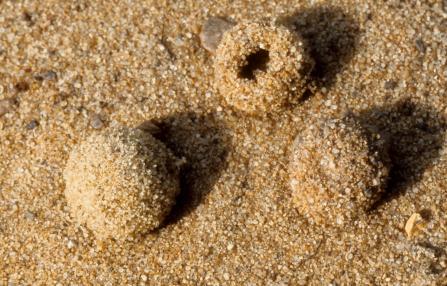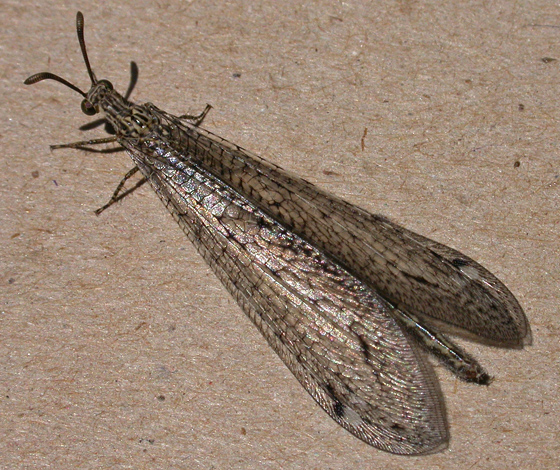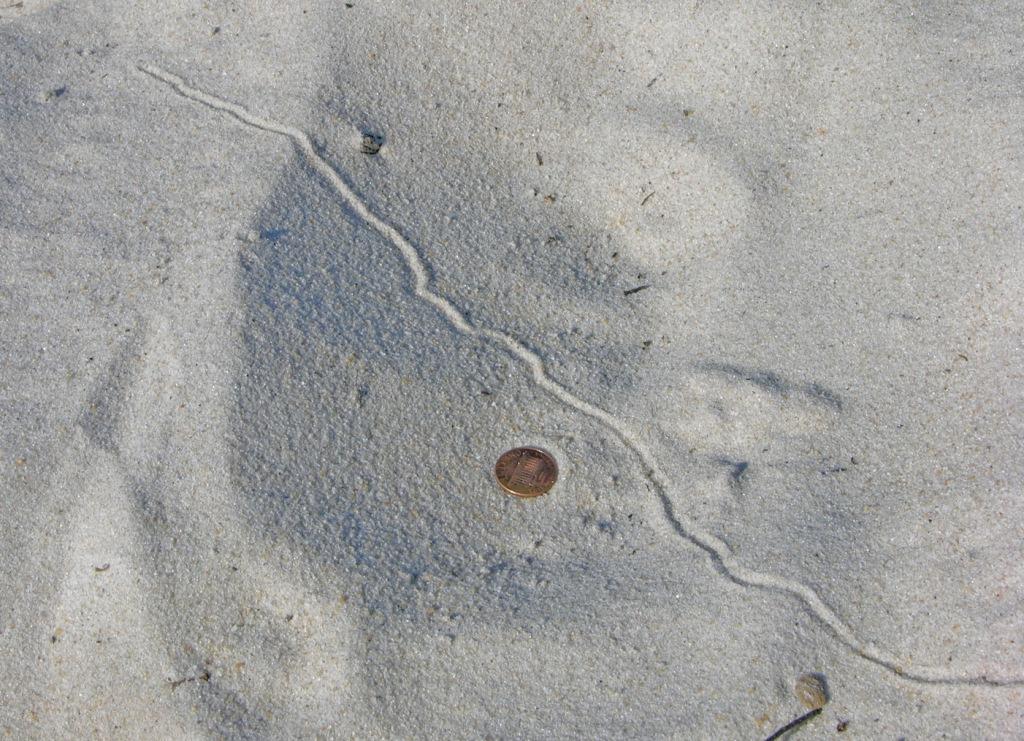 In the winter, the antlion does not hide under kitchen rugs, munching on Dorito crumbs till warmer days arrive; instead he is outside in larval form buried beneath the ground's surface. In fact, the antlion spends most of his life in the larval stage. Like many invertebrates, the antlion undergoes metamorphis. He begins life in the summer as an egg and overwinters through the spring. In early spring, the larva hatches from the egg and digs down below ground level to spend the next 1-3 years. When weather conditions are consistently warm enough, the larva will pupate in a silky cocoon (at left) and later emerge as a nocturnal adult. He is similar-looking to a damselfly or lacewing only with clubbed antennae and a more delicate morphology (bottom picture).
In the winter, the antlion does not hide under kitchen rugs, munching on Dorito crumbs till warmer days arrive; instead he is outside in larval form buried beneath the ground's surface. In fact, the antlion spends most of his life in the larval stage. Like many invertebrates, the antlion undergoes metamorphis. He begins life in the summer as an egg and overwinters through the spring. In early spring, the larva hatches from the egg and digs down below ground level to spend the next 1-3 years. When weather conditions are consistently warm enough, the larva will pupate in a silky cocoon (at left) and later emerge as a nocturnal adult. He is similar-looking to a damselfly or lacewing only with clubbed antennae and a more delicate morphology (bottom picture).
 The antlion's summer residence is a conical depression or "pit" about an inch deep and an inch or two in diameter (at right). He expertly engineers a pit in soft sand and friable, dry soils. The antlion builds these steep depressions to capture ants or other small bugs walking on the ground's surface. He waits motionless, just under the bottom of his pit, for a victim to fall in. Once the unsuspecting prey falls over the lip, the antlion kicks up sand to disorient and bring it closer to his large, over-sized jaws. The antlion injects a venom into his prey to immobilize it and liquefy its guts. He then sucks the innards out and disposes of the exoskeleton before finding his next meal.
The antlion's summer residence is a conical depression or "pit" about an inch deep and an inch or two in diameter (at right). He expertly engineers a pit in soft sand and friable, dry soils. The antlion builds these steep depressions to capture ants or other small bugs walking on the ground's surface. He waits motionless, just under the bottom of his pit, for a victim to fall in. Once the unsuspecting prey falls over the lip, the antlion kicks up sand to disorient and bring it closer to his large, over-sized jaws. The antlion injects a venom into his prey to immobilize it and liquefy its guts. He then sucks the innards out and disposes of the exoskeleton before finding his next meal.
 Antlions belong to the family of nerve-winged insects known as Neuroptera. The Myrmeleontidae family is one of the most well-known families of Neuroptera, named after the larva in the genus Myrmeleon or the "antlions". The charismatic antlion is common and native to the United States. They can be found throughout Wisconsin in habitats such as beaches, sandy forests, and farmlands. There are about 100 antlion species in North America and over 2,000 world-wide.
Antlions belong to the family of nerve-winged insects known as Neuroptera. The Myrmeleontidae family is one of the most well-known families of Neuroptera, named after the larva in the genus Myrmeleon or the "antlions". The charismatic antlion is common and native to the United States. They can be found throughout Wisconsin in habitats such as beaches, sandy forests, and farmlands. There are about 100 antlion species in North America and over 2,000 world-wide.
Fun Facts:
 Help, I'm stuck in reverse! The antlion, also commonly known as a "doodle bug", cannot move forward. He travels in a backward direction and leaves little scribbles or "doodle" trails in the sand as he goes (at right).
Help, I'm stuck in reverse! The antlion, also commonly known as a "doodle bug", cannot move forward. He travels in a backward direction and leaves little scribbles or "doodle" trails in the sand as he goes (at right).- Learn how to be a doodle bug whisperer! Folklore states that if you lean over a doodle bug pit and repeat the phrase "doodle bug, doodle bug, come into view", it will spit sand and move. There is some truth in the legend. Doodle bugs respond to vibrations and the human voice can cause just the right amount of vibration to spring an antlion to action.
- The name Myrmeleon is a Greek word which translates to mean "ant lion".
- What?! An antlion can't poop. It has no anus and stores waste internally. Eww!!
- Antlions have been the inspiration for many sci-fi creatures in movies, television shows and video games.
- It's a rough life for an adult antlion. They are weak fliers and spend their days hiding from predators. They live only a month as adults; just long enough to reproduce.
- Antlions have been admired by engineers and scientists for years. Click on this video to watch an antlion at its best.
***Do you find bugs fascinating? Are you inspired by 6-legged creatures rather than repulsed? If your answer is "yes", we are looking for you! The research and community science department is recruiting people who are interested in invertebrates to form a group that will help guide volunteers in creating and carrying out an original research project involving bugs. No need to be a bug expert or love all types of bugs. Informational sessions about possible involvement in this group will take place January 23rd and 28th at 6 pm at Riverside Park. Sessions do not tie you to involvement and are meant solely to be informative. Please contact This email address is being protected from spambots. You need JavaScript enabled to view it. if you are interested but can't attend or for any additional questions.
*This article was written using resources from the books Field Guide to the Insects of North America by Eric R. Eaton and Kenn Kaufman and Insects: Their Natural History and Diversity by Stephen Marshall and the websites www.uwm.edu and www.dnr.wi.gov.





